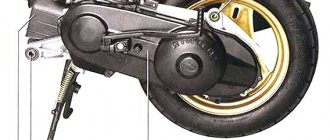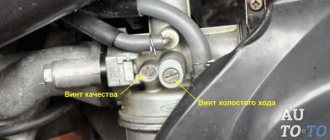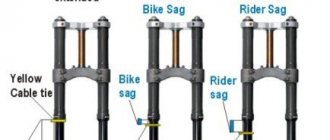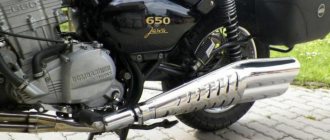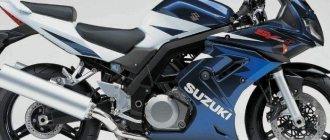Publication date: December 01, 2021. Category: Motor vehicles.
Some owners of “iron horses” consider the speedometer to be the main measuring instrument installed on a motorcycle. Of course, the speed at which you are moving is important information (especially for traffic police officers). However, only a tachometer, informing the motorcyclist about the number of engine revolutions, will help “tell” whether the gear is selected correctly for a given speed. Not all bikes are equipped with this useful device. Installing a tachometer on a motorcycle with your own hands is now quite simple.
Purpose and principle of operation of the tachometer
A tachometer is a device that measures the number of revolutions of a motorcycle engine in one minute and displays this information on the dashboard (in an easy-to-read form). The readings of this device are necessary for a motorcyclist (especially a beginner) to:
- timely gearbox speed switching: as soon as the engine speed increases to a certain value, it is necessary to switch to a higher gear and vice versa;
- preventing the operation of the motorcycle power unit at extreme conditions (this is indicated by the red sector of the tachometer);
- fuel economy if the engine operates at optimal speed (the one most appropriate to the gear engaged, the load on the motorcycle and road conditions).
The dashboard of many modern bikes is initially equipped with this useful “informant”. However, in the vast expanses of our Motherland, there are still a huge number of Soviet and Russian-made motorcycles in use (for example, “Ural”, “IZH”, “Voskhod”) that are not equipped with tachometers. By the way, many models of the legendary Harley Davidson and Triumph also do not have standard engine speed indicators. A tachometer for a motorcycle that was not installed during construction can be purchased and installed yourself.
Using tachometers for motorcycles
The tachometer is one of the most important devices for any vehicle. It is used to measure engine speed. As you know, almost every motorcyclist is a fan of fast riding. Therefore, they often encounter breakdowns of their “iron horse”. This happens due to the fact that not every motorcycle can withstand heavy engine load.
A motorcycle tachometer is used to monitor engine speed. It shows how many revolutions the engine makes at a certain speed. Thanks to this, motorcyclists are able to control the speed of their motorcycle so as not to put stress on the engine, which can very quickly fail under intensive use.
There is a wide variety of tachometers on the domestic market. Every motorcyclist has the choice of either purchasing a ready-made device for his bike or making it himself.
A tachometer for motorcycles allows the engine to last as long as possible.
Models, manufacturers and prices
The range of tachometers intended for installation on motorcycles, mopeds and scooters is very diverse both in price, design, execution (with an arrow or digital display), and in the number of manufacturers producing products for this purpose.
A universal electronic tachometer (from Chinese or “Kkmoon”) with LED backlight in a stainless steel case (Ø=56 mm, case height – 60 mm) costs only 540÷650 rubles.
For the same 500÷700 rubles you can purchase products with a digital indication of the number of revolutions per minute from Ironwalls or FCD.
Owners of expensive and prestigious brands of motorcycles (however, those not equipped with a standard tachometer) can purchase and install products from the world-famous and well-established Baron, Koso, J&P Cycles or Sunpro. However, the cost of these products will already range from 3,000 to 12,000 rubles.
Installation and connection
Installation of tachometers additionally installed on a motorcycle is quite simple. A bracket attached to the body of the product allows you to easily install the device on one of the bolts securing the steering wheel to the fork.
Installing the products on the steering wheel in the most convenient place for viewing will allow the use of a special fastening coupling for installing additional equipment. It can be easily purchased for 200–300 rubles at any motorcycle accessories store. Some tachometer models have such fastening devices already included in the delivery kit.
Some manufacturers supply a complete set of a wide variety of fasteners and wires for connection along with the measuring device itself.
The connection diagram is quite simple and will not cause difficulties even for bikers who are not very “advanced” in electrical engineering (note: the colors of the wires are indicated for tachometers from Chinese manufacturers):
- We connect one short wire (usually black) to the switched “+” of the ignition switch;
- the second short one (green) – to the motorcycle frame (in a convenient place);
- the third short (black and yellow) - to the low-voltage contact of the coil going to the breaker;
- two long thin wires (black and red) - parallel to the speedometer light bulb.
This is interesting: The new Camry breaks records for the number of intrigued fans
Important! The tachometer connection wires from American and European manufacturers have different colors. But unlike Chinese suppliers, the kit necessarily includes a diagram for connecting the device.
Connection diagram for tachometer to motorcycle
The diagram for connecting a tachometer to a motorcycle is not fundamentally different from its installation on a VAZ-2106 car. The input of the device is connected to the output of the primary winding of the coil, after which the positive and negative wires are connected to the battery. Installing the toggle switch on the positive line will significantly save battery power when the motorcycle is idle.
A two-cylinder unit with single-channel ignition must be equipped with a rectifier. The battery that powers the tachometer is connected to its output. When the TX-193 is directly connected to the generator, the device will fail in the shortest possible time.
In the case of dual-channel ignition, to transmit pulses from both cylinders it is necessary to create an identical tachometer input line. After drilling an additional hole in the bottom, connect the wire to the device terminal.
Three-cylinder motorcycles are usually equipped with three-channel ignition systems. In this case, the connection to the tachometer is made from any two coils. In the same way, pulses are supplied in multi-cylinder equipment, but here it is more advisable to use models designed for this type of engine.
Connecting a tachometer to a single-cylinder unit is a little more complicated. Here it is necessary to adjust the resistor R7, which is responsible for the sensitivity of the measuring device. If necessary (lack of power), you should double the power of capacitor C5, and then readjust the resistor.
Bounce errors
To scare you, I will assume that we are measuring the engine speed from an inductive ignition sensor. That is, roughly speaking, a piece of cable is wound around a high-voltage wire and we measure the induction in it. This is a fairly common method, isn't it? What could be so complicated about this? The main problem is modern ignition systems; they give not just one impulse, but a bunch at once.
Like that:
But even a conventional ignition system produces transients:
Old cam contacts generally show wonderful pictures.
How to deal with this? The rotation speed cannot increase instantly, inertia will not allow it. In addition, at the beginning of the article I suggested limiting the frequency from above to reasonable limits. Counts that occur too often can simply be ignored.
MinimumInterval = ( 1 / ( K * MaximumReasonableFrequency) ) const byte fqPin = 2; // For ATMega32 only 2 or 3. const int K = 1; const unsigned long maxFq = 20000; // rpm (revolutions per minute) const unsigned long minInterval = 1000000UL / ( K * maxFq ); // minimum interval in microseconds volatile unsigned long counter; // Number of samples. volatile unsigned long mks; // Time of the last count. unsigned long oldTime; // Time of the last count in the previous calculation. // Function for handling the interrupt. void ISR() { // Interrupt code here static unsigned long oldTmr; // save the old timer unsigned long tmr=microseconds(); if (tmr - oldTmr > minImterval) { mks=microseconds(); counter++; oldTmr=tmr; } } void setup() { Serial.begin(115200); // Connect the ISR function to interrupt when a signal appears on the fqPin leg. attachInterrupt(digitalPinToInterrupt(fqPin), ISR, RISING); } void loop() { unsigned long rpm; // Receive data. noInterrupts(); unsigned long cnt = counter; counter = 0; unsigned long tmr = mks; interrupts(); // Output the frequency in revolutions per second if (cnt > 0) { rpm = K * 1000000UL / ((tmr - oldTime) / cnt); oldTime = tmr; } else { rpm = 0; } Serial.println(rpm); delay(250); }
Another type of interference is missing samples. Because of the same inertia, your frequency cannot change twice in one millisecond. Obviously, this depends on what you are actually measuring. The frequency of a mosquito's wingbeat can probably drop to zero within a millisecond.
Statistical processing in this case becomes quite complex for a small interrupt handling function, and I am ready to discuss options in the comments.
We recommend reading:
Feasibility of direct flow, installation instructions
Nowadays, it is not at all difficult to acquire a speed meter for further installation on a bike. As a tachometer on the Izh Jupiter 5 and other Izhmoto models, as mentioned above, the speed meter that is equipped with the VAZ 2106 car (simply popularly called the “Zhiguli Six”) can be safely used. This product can fit well into the standard panel of these Russian Soviet motorcycles In this case, connecting the tachometer to the Izh involves cutting its body to half. All connectors that are connected to the light devices (indicators) of the dashboard must be lowered to the lower limit. After installation, the tachometer on the motorcycle must not sit unevenly, resting against wires and other elements standard bike design.
How to install a tachometer on an Izh
Note that the Izh planet tachometer is designed according to a similar scheme of actions.
There is no need to move the control lamps if the latter are replaced with a box with LEDs. You yourself will appreciate the super-bright indicators of the latter above the brightness that the light indicator elements had in the standard form of the iron horse. You can attach the above box (socket) with LEDs to the end of the tidy. And the body of the latter itself is not difficult to create, using, for example, cases from an old audio cassette. Not a bad excursion into the 1990s, isn't it?
The tachometer on the Ural motorcycle can be equipped according to a similar principle, replacing the speedometer or moving the device for measuring revolutions to a separate area at the steering wheel. Connecting tachometers to an Izh motorcycle is carried out independently with the same success and simplicity as the installation of the latter itself. You can make a colored outline around the new location for the design of light bulbs or LEDs. A bright circle, mostly of a light color, is drawn around each light element. After such a simple innovation, your devices (indicators) will look much better.
How to connect a tachometer to an Izh motorcycle?
After securing the tachometers, you can begin connecting their wires to the electrical wiring elements of the bike.
Simply put, our semi-homemade Izh Planet tachometer, or a device that will work on another bike, has only three wires. The mass goes to the frame of the iron horse.
The plus is connected to the ignition switch (to the positive terminal that comes from the battery). The third wire is mounted on a coil. In the case of the tachometer on Izh Jupiter 5 and other two-cylinder Soviet bikes, there is no difference at all which coil to connect to. The easiest way is to separate the wire to connect to both.
Note that the wire going to the coil needs to be equipped with a “d226d” diode. Often a tachometer is installed on a motorcycle by replacing a capacitor of 0.22 μF (microfarad) with a product with a value of 0.47 μF, for example. This innovation allows you to modernize the bike for use on an Izh motorcycle. The connection diagram for the last wire looks like this.
